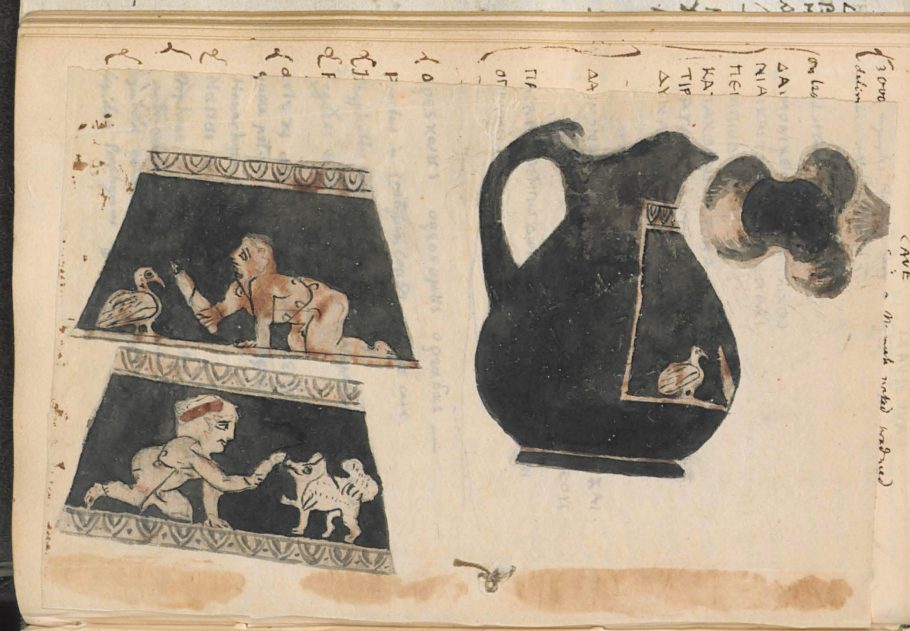The William Gell notebooks at the BSA
Or will the gentle dilettanti crew
Now delegate the task to digging Gell,
That might limner of a bird’s-eye view,
How like to nature let his volumes tell;
Who can with him the folio’s limits swell
With all the author saw, or said he saw?
Who can topographize or delve so well?
No boaster he, nor impudent and raw,
His pencil, pen, and shade, alike without a flaw.(Byron, manuscript of Childe Harold’s Pilgrimage, British Library)
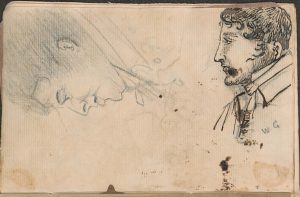
Self? portrait of William Gell (Notebook 4, GELL 4534c)
Six notebooks by William Gell were acquired by the BSA in 1924. They had been purchased the previous year, together with several others, from a book dealer in Naples by Thomas Ashby, Director of the British School at Rome, who kept those pertaining to Italy but thought that the notebooks concerning Greece would be better housed at the BSA.
Sir William Gell (1777- 1836), Classical scholar, antiquary and traveller, was a remarkable man whose skill as a topographer and draughtsman so impressed Byron that it inspired him to initially weave the above lines into his great narrative poem, Childe Harold’s Pilgrimage. Gell not only published extensively but also produced hundreds of meticulous sketches, maps and finished drawings. His papers, consisting of unpublished manuscripts, sketch-books, journals and letters, were inherited first by Gell’s life-long friend the Hon. Richard Keppel Craven and then later, with the exception of thirteen sketchbooks which Gell had wished to bequeath to the British Museum, by Craven’s secretary Andrea Pasquini in 1851. It was at some point after this that Gell’s collection was dispersed. A great many turned up on the art market at the beginning of the twentieth century while others are still to this day coming to light from time to time.
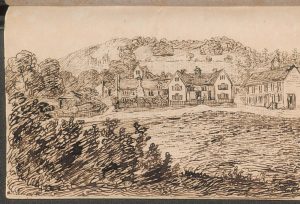
View of Hopton Hall (Notebook 4, GELL 4534c)
William Gell was the second son of Philip Gell of Hopton Hall near Wirksworth in the Derbyshire Dales, owner of several lead mines in the surrounding area. They were from one of the oldest families in England, with a tradition of service in the Army, Navy, Parliament and the Church going back to 1209. At the age of sixteen, Gell was admitted as a pensioner (undergraduate without financial support from the college) at Emmanuel College, Cambridge on Oct. 6, 1793. He graduated BA in 1798 and was elected a Fellow of the College. It was at Cambridge that Gell must have become acquainted with Edward Dodwell, and together, at the end of 1800, they embarked on their first voyage to Greece and Asia Minor accompanied by a Mr Atkins about whom almost nothing is known other than a few fleeting references and a handful of drawings at the Benaki Museum. Gell’s diary from this journey survives as do many of the sketches he produced.
In 1804 Gell migrated to Jesus College, upgraded to MA and published his first book, The Topography of Troy. He returned to Greece the following year travelling again, at times, with Dodwell. Dodwell’s intention on this tour was to work on his forthcoming publication, A Classical and Topographical Tour Through Greece in the Years 1801, 1805, and 1806, and for this purpose he employed the Italian artist Simone Pomardi to assist him with drawing landscape views, as well as ancient monuments and sites. At the same time, Gell was conducting research for his own publications, The Geography and Antiquities of Ithaca, which appeared in 1807, and The Itinerary of Greece, with a commentary on Pausanias and Strabo, and an account of the Monuments of Antiquity at present existing in that country, compiled in the years 1801,2,5,6 etc. in 1810. Several of the BSA notebooks date from this time. Notebook 6 (GELL 4534a), for example, records angles and bearings that Gell diligently took. It is quite remarkable and is a testament to his dedication and an example of the painstaking working methods of early topographers.
Of special interest is Notebook 1 (GELL 4534b) which comprises detailed notes for Itinerary of Greece; containing one hundred routes in Attica, Boeotia, Phocis, Locris, and Thessaly of 1819. This publication was intended as a guide-book providing practical information on routes to follow and cannot be described as a page-turner. The notebook begins – ‘Thermometer 80 in Temp. of Jupiter July 5 Friday 1805 / Leave gate by the garden near monastery of Athens at 4 p[ast] 8. 11 ½ / Philopappus R[ight]. 23 p 8 cross Illisus – 32 p 8 gardens & houses. 20 p 9 / at the traces of wheels & theatre of Piraeus. 27 p 9 Custom house…’ (GELL_4534b_003) – and continues in this vein. However, interspersed, albeit sparingly, are some amusing incidents and snippets of information of a more personal nature which did not make it into print. Early travellers often wrote of dangerous encounters with ferocious dogs. Richard Chandler’s Travels in Asia Minor and Greece, for example, is full of such anecdotes, but Gell, greatly fond of canines, did not seem to be in the least perturbed and dealt with matters in an altogether different way: ‘Here a dog wonderfully delighted at my imitating a hen’s clucking having been at first savage came & became very familiar.’ (GELL_4534b_011) We learn, too, that the travellers were invited to join in a marriage celebration at Daulis: ‘pretty houses have gardens A marriage, went to it, tables not vast round the room. Terrible music. The nymphi stood up all time making bows. The bride or γαμβρός [groom] brought us wine made a bow presented the glass & kissed our hands Dancing sometimes good. People very civil.’ (GELL_4534b_021) I don’t imagine Gell was persuaded to join in the dancing, but he did produce a lively sketch of the scene.
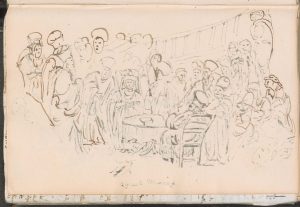
A Greek marriage (Notebook 1, GELL 4534b)
Two sheets of paper with drawings of vases have been inserted into this notebook. They are remarkably similar to drawings in a notebook at the British Museum which belonged originally to Dodwell, though I don’t believe they are by the same hand, BM Museum number 2012,5019.1.6 and BM Museum number 2012,5019.1.8. The lekythos features in an engraving by H. Moses after a drawing by Pomardi in Dodwell’s publication with the following text:
‘But the most singular instance of duplicate vases, is one which I saw taken from an hypogaia sepulchre in the Acropolis of Athens. This represents a duel between two warriors, completely armed, guarded with the round Argolic shield, and fighting with the long spear. By the side of each combatant a herald is represented, holding a spear, and clothed in a long loose garment. The top of the vase is ornamented with a dog chasing a hare. A duplicate of this [published by Mr Millingen] was found at Nola…a fifth was purchased by me at Rome; and a sixth [by Colonel Leake] was found near Athens…these are all of the same size and form…there can be no doubt that they were copied from some standard original.’
Gell’s notebook provides some additional information, recording that the vase was found near the Propylaia in 1805. The British Museum drawing of the chous, the more accomplished and probably more faithful of the two drawings, was also drawn by Pomardi but gives no further information other than that it was found at Athens.
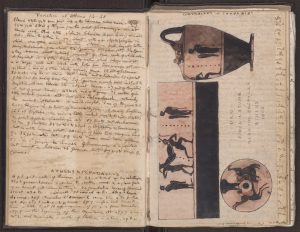
Study of a lekythos (Notebook 1, GELL 4534b)
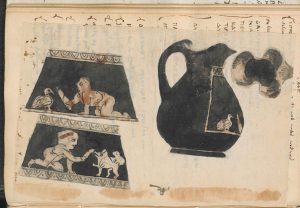
Study of chous (Notebook 1, 4534b)
Gell studiously recorded the antiquities he came across. Notebook 5 (GELL 4534e) is titled ‘Book of Marble Acroteria &c.’ and is full of examples including those found by his circle of friends in Athens, Carl Haller von Hallerstein, Otto Magnus von Stackelberg, Louis-François-Sébastien Fauvel, the French consul, and George Christian Gropius his Austrian counterpart.
Playful additions, such as a trompe l’oeil fly and ant among his recordings of inscriptions in Notebook 3 (GELL 4534d) and his critical remark under the notebook manufacturer’s stamp in Notebook 2 (GELL 4534f) add a more personal touch, providing not only an insight into his character but also bringing a sense of immediacy to these notebooks written over two hundred years ago.
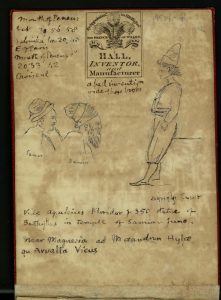
‘A bad invention vide these books’ (Notebook 2, GELL 4534f)
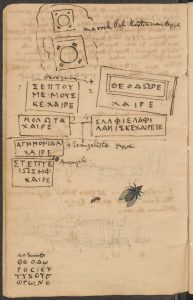
Trompe l’oeil fly and ant among recordings of inscriptions (Notebook 3, GELL 4534d)
Known and respected through his publications, Gell was selected by the Society of Dilettanti in 1811 (Gell had been elected a member of the Society in 1807) to lead a second archaeological expedition to Asia Minor. Founded in 1734 by a group of like-minded noblemen who had been on the Grand Tour, the Society of Dilettanti was not just a convivial drinking club – Horace Walpole once famously quipped that it was a ‘club for which the nominal qualification is having been in Italy, and the real one, being drunk’ – but it was also concerned with more serious pursuits and financially supported the study of ancient Greek and Roman art. The expedition followed that undertaken by the antiquary Richard Chandler, the architect Nicholas Revett and the painter William Pars some 47 years earlier. Appointed to assist Gell were the architects John Peter Gandy, who had attended the Royal Academy Schools before becoming a pupil of James Wyatt, and Francis Octavius Bedford, a former clerk of Sir John Soane. Accompanying them at his own expense was Keppel Craven.
The main objective of the Dilettanti Society in sponsoring these missions, as was clearly stated in a list of instructions put together by Lord Aberdeen and reiterated in the short account of the proceedings of the Mission printed in 1814, was ‘to promote the progress of architecture by affording practical assistance to the architects of this country, as well as to gratify a general curiosity respecting the interesting monuments of antiquity still remaining in those parts’. ‘Most elegant’ plans and elevations were to be produced in order for the Society to engrave them and ‘offer them to the public for the improvement of national taste’. The results of the missions (there was also a third conducted by Richard Popplewell Pullan in 1862) were published, often after much delay, in sumptuous volumes entitled, Unedited Antiquities of Attica, Ionian Antiquities, and Antiquities of Ionia.
Gell was instructed to ‘procure the exactest plans and measures possible of the buildings you shall find, making accurate drawings of the basreliefs and ornaments, and taking such views as you shall judge proper, copying all the inscriptions you shall meet with, and remarking such circumstances as they contribute towards giving the best idea of the ancient and present state of those places.’ The architect William Wilkins advised the Society which monuments should be examined and it was decided that the places of most interest to Society were Samos, Aphrodisias, Tralles, Telmessus, Patara, and Cnidus. Also on the list were Sardis, Laodicea, and Hierapolis but outbreak of the plague prevented travel in these regions. Instead, the travellers explored Didyma, Cos, Myra, Antiphellus Magnesia and Priene. Finding themselves detained for some time at Athens, they also turned their attention to Eleusis (where they discovered among other things the Temple of Ceres), Thoricum and the Temple of Nemesis at Rhamnus.
Around 500 drawings by Gell, Gandy and Bedford were produced during the course of the expedition and were handed over to the Society of Dilettanti upon their return. A three-volume journal was also presented to the Society which had been written up neatly by Gell with the aid of his field notebooks. Notebook 2 (GELL 4534f), very small and bound in red leather, is one such notebook used by Gell on his travels. It begins when the travellers departed from Athens on 30 April 1812, sailed to Smyrna, and then on to Chios, Samos, Didyma, Cos, Halicarnassus, Cnidus, and ends when the travellers reached Rhodes on 17 July 1812. One of the British Museum notebooks recently acquired from Rome is identical in form to this notebook at the BSA and picks up from where the latter finishes, beginning on 30 July 1812. Both of these field notebooks form an integral part of the archive material connected to the Ionian Missions.
This fascinating collection of notebooks at the BSA give an insight into the working methods of Gell and are an illustration of the sheer dedication of his undertaking on all of his journeys despite lack of comfort – ‘Logothete’s house a discomfiture. Quit house because it was so cold and dirty’ (GELL_4534b_019) – and the crippling effects of gout – ‘Stay all next day laid up with rheumatism in foot / 23 October 1805’ (GELL_4534b_017). The significance of the notebooks, however, lies in Gell’s recording of inscriptions and antiquities, some of which have not survived, and also in the fact that they provide important textual information regarding the sketch-books at the British Museum and the Bodleian Library.
Celeste Farge
Department of Greece and Rome
The British Museum
The William Gell Papers are now available on the BSA’s Digital Collections.
Click here for more BSA Archive Stories.
Further reading:
A.M. Woodward and R.P. Austin, ‘Some note-books of Sir William Gell I’, The Annual of the BSA 27, 1925-6, pp. 67-80 and 28, 1926-7, pp. 107-127
E. Clay and M. Frederiksen (eds.), Sir William Gell in Italy: letters to the Society of Dilettanti, 1831–1835, 1976
R. Sweet, ‘William Gell and Pompeiana 1817-1832’, Papers of the British School at Rome, Vol. 83, 2015, pp. 245-281
J. Thompson, Queen Caroline and Sir William Gell: A Study in Royal Patronage and Classical Scholarship, 2019
